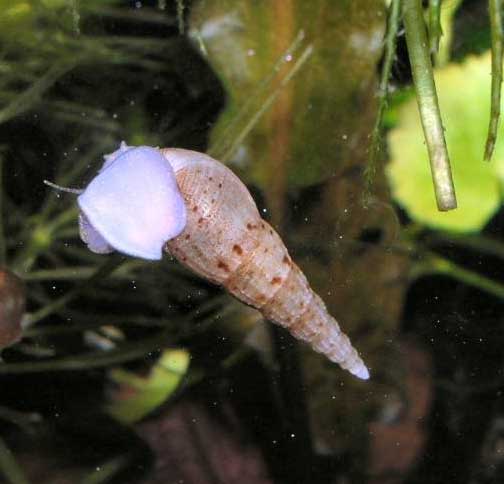Melanoides tuberculatа Cladus: Eukaryota Name Melanoides tuberculatа O. F. Müller, 1774 Vernacular names ------------ This species has an elongate, conical shell, which is usually light brown, marked with rust-colored spots. An operculum is present. The average shell length is about 20-27 mm[4] or 30-36 mm, but exceptional specimens may be up to 80 mm long. Shells of this species have 10–15 whorls.[4] Distribution This species is native to subtropical and tropical Africa and Asia. Prehistoric localities include Gobero in Niger in 6200–5200 B.C.E.[5] Nonindigenous distribution * United States since 1930s (see below) This species can also be found in artificially-heated indoor habitats, such as aquaria in greenhouses, and similar biotopes: * Czech Republic
This species has become established outside of its natural range in large part through the activities of aquarists.[3] These snails were imported to the United States by the aquarium trade as early as the 1930s. Established populations exist from Florida to Texas, and the species may still be expanding its range in the West and Northeast. Some of these exotic populations have become very large, with densities of 10,000 per square metre being reported from the St. Johns River in Florida.[11] In some cases red-rimmed melanias are believed to have a negative impact on native snail populations.[3] The nonindigenous distribution includes the United States: Arizona; San Francisco Bay, California (Ruiz 2000) ; Colorado; Florida; Hawai'i; Louisiana (Dundee 1977) ; Montana; North Carolina; Nevada; Oregon; Utah (USFWS 2005) ; and Texas (USFWS 2005) . (Unconfirmed in South Dakota, Virginia, and Wyoming.) Ecology This is primarily a burrowing species that tends to be most active at night. Habitat Although normally a freshwater snail, this species is very tolerant of brackish water, and has been recorded in waters with a salinity of 32.5 ppt(1,024 specific gravity salinity). It is however a warm-climate species. It appears to prefer a temperature range of 18 to 25°C[3] or of 18 to 32°C. Research has been conducted to determine the snail's lethal high water temperature, which is about 50°C (120 degrees Fahrenheit). This information is helpful in the disinfection of fishing gear and research equipment, which otherwise may inadvertently spread the snails to uninfested waters.[12] This species is resistant to low oxygen levels.[13] Feeding habits This snail feeds primarily on algae (microalgae). Life cycle Red-rimmed melania females are both parthenogenic and sexual. Females can be recognized by their greenish coloured gonads while males have reddish gonads. Under good conditions, females will produce fertilised eggs that are transferred to a brood pouch where they remain until they hatch (parthenogenesis and viviparity)[11] Snails will begin reproducing at a size as small as 10 mm in length and broods may contain over seventy offspring(iteroparity).[3] Parasites Melanoides tuberculatus is known to carry certain parasites which can be dangerous to humans. These snails serve as first intermediate host for parasites which include:[3][13]: * Clonorchis sinensis - Chinese liver fluke This species is a host for a trematode parasite which has been found to infect an endangered species of fish in Texas, the fountain darter. Agricultural pests Red-rimmed melanias can sometimes be an agricultural pest species, as has been reported on Chinese cabbage plantations in Hong Kong.[3] Aquaria Red-rimmed melanias are quite commonly found in freshwater aquaria, but opinion in the hobby is divided between those who see them as a pest species, and those who value their usefulness as algae-eaters and substrate-cleaners.[14] Among aquarists, these snails are known as Malayan livebearing snails or Malayan/Malaysian trumpet snails (often abbreviated to MTS).[11] References 1. ^ IUCN 2008. 2008 IUCN Red List of Threatened Species. <www.iucnredlist.org>. Downloaded on 27 October 2008. This article incorporates public domain text from: * Benson, A. J.. 2008. Melanoides tuberculatus. USGS Nonindigenous Aquatic Species Database, Gainesville, FL. <http://nas.er.usgs.gov/queries/FactSheet.asp?speciesID=1037> Revision Date: 4/24/2006.
* Andrew J. Mitchella & Thomas M. Brandt. (January 2005). "Temperature Tolerance of Red-Rim Melania Melanoides tuberculatus, an Exotic Aquatic Snail Established in the United States". Transactions of the American Fisheries Society 134(1): 126–131. doi:10.1577/FT03-178.1, abstract interactions with Biomphalaria glabrata: * Pointier J. P. (1993). "The introduction of Melanoides tuberculata (Mollusca: Thiaridae) to the island of Saint Lucia (West Indies) and its role in the decline of Biomphalaria glabrata, the snail intermediate host of Schistosoma mansoni''. Acta Trop. 54:13-18. Source: Wikispecies, Wikipedia: All text is available under the terms of the GNU Free Documentation License |
|

